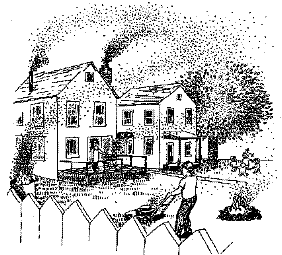The Burning Issues Project
Wood Smoke Pollution In The Bay Area
Greg Jalbert
| Burning Issues has an extensive Web site, with lots of important information, a large bibliography, and a slide show: http://www.burningissues.org/ |
In the Bay Area, a pollution crisis is hovering right over our heads. There is a group of people based in Los Altos, California that is working intensely on uncovering the hidden dangers of wood smoke pollution.
 Headed by Mary Rozenberg, an engaging women with boundless energy and a sense of purpose, Burning Issues is an organization dedicated to making the public aware of smoke and dust pollution. Burning Issues is now working with The Loma Prieta Chapter of the Sierra Club on the Particulate Pollution Project.
Headed by Mary Rozenberg, an engaging women with boundless energy and a sense of purpose, Burning Issues is an organization dedicated to making the public aware of smoke and dust pollution. Burning Issues is now working with The Loma Prieta Chapter of the Sierra Club on the Particulate Pollution Project.
Particulate air pollution has many sources. Some, such as dust from construction, have already been affected by government legislation. Some, like the problem with vehicular emissions, are so complex that solutions will take a lot of time and money. An easy solution to the problem of smoking fuels such as coal, charcoal, and wood is to ban their use. Here are some reasons why: Particulates are small particles in the air. The most dangerous particulates are those less than 10 microns in diameter, about one tenth the thickness of a strand of hair. Particulates this size are called PM10. When a fuel is not completely burned, the compounds it is made of combine and react to the heat, producing new compounds.
Joel Schwartz, of the EPA, says, "...as many as 60,000 U.S. residents per year die from breathing particulates at or below legally allowed levels."
"...findings suggest that particulates are more toxic than smog ozone" says Bart Ostro, the Chief of Air Pollution Epidemiology at the California Department of Health Services. Although PM10 particulates exceed limits more than any other pollutant, the levels are only monitored every six days in parts of California. The presence of PM10 at ground level rises dramatically in the early evening and stays high during the night due to a temperature air inversion. The inversion forces smoke to stay close to the ground. Since the air in a house is completely exchanged with outside air approximately once every two hours, it is impossible to hide. 50% to 70% of air and air pollutants outside a "closed" house get inside.
30% to 50% of winter pollution (particulates and dangerous chemicals) come from burning during the winter. Wood stoves pollute more than fireplaces. Dario Levaggi, Director of Technical Services of the Bay Area Air Quality Management District, says, "Wood stoves and fireplace inserts, designed to burn slowly..., do not burn the wood as completely as do fireplaces. For that reason, wood stoves and fireplace inserts are worse polluters." Serious illness and death is associated with particulate pollution. The toxins are inescapable, indoors and out. A study by Dr. Fairley in Santa Clara for the years 1980-1986 shows a significant association between daily mortality and PM 10 even when ambient air quality standards were barely exceeded. Among the chemicals produced by wood burning are carbon monoxide, formaldehyde, nitrogen dioxide, and sulfur dioxide, all known to cause respiratory and heart problems.
An example of a pollution disaster in history is the 1952 London smog, which killed 4,000 people in four days. Deaths from bronchitis increased 9 fold. This disaster should have taught us of the potential dangers of weather and pollution in combination. The Bay Area, a valley containing pollution like a bowl, may be the setting for another environmental crisis. Weather conditions in combination with particulate pollution may trigger a dramatic rise in respiratory diseases and deaths. An EPA study concludes that breathing wood smoke particles during high pollution days is equivalent to smoking 4 to 16 cigarettes.
Contrary to what you might imagine, the cost of heating your house with wood in the San Francisco Bay Area is a lot more than the cost of heating with gas, and gas heat generates relatively no particulate pollution. It costs about $235 for a cord of wood in the Bay Area, but less than $70 for the equivalent amount of heat from a gas furnace.
The correlations and discoveries of the Burning Issues group make it clear that it is dangerous to use of wood for heating, and that the health problems of the growing population will increase unless people become aware of the situation and make significant changes in their lifestyles.
For more information about Burning Issues and the Particulate Pollution Project, write to:
Burning Issues
Box 1045
Point Arena, CA, 95468 USA
Tel: 707-882-3601
E-mail: pm10mary@mcn.org
Burning Issues has an extensive Web site, with lots of important information, a large bibliography, and a slide show: http://www.burningissues.org/. Burning Issues is a project of Clean Air Revival, Inc..
Back to Asphalt Strawberry: Environment
